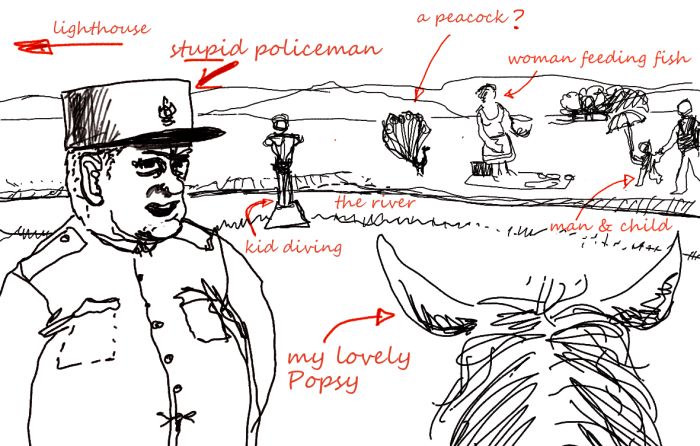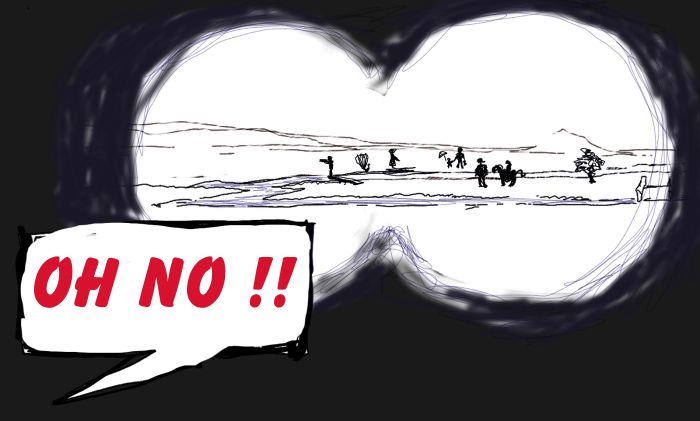Simple Scene
Describing from different perspectives
How would you describe the scene in the drawing ?

There is a fundamental difference between describing in a picture, and describing with language. A picture happens in space ... you see the pattern at once. Whereas language happens in time ... there is a sequence of words, one after another, until your idea of the scene is complete.
(Actually, pictures happen in time as well - you can grasp the overall pattern, or gestalt, at a glance, but then your eye moves around the picture, gathering detail and adding to the overall pattern. Conversely, words lead to the formation of a visual structure in the brain - there is a kind of 'virtual' picture which has an overall pattern of space, too.)
Accordingly, if we are using words to describe, sequence matters ... we have to start somewhere and end somewhere, and it makes a difference which way round we organise the details.
.
** You might like to relate this page to Bill Bryson's clever use of some of these techniques, studied in the page Sydney & sleep
Sequencing
The first two sequences really involve describing the picture itself.
Back-to-front ... 
you describe the general setting, then fill in more details closer to hand, then come to the details which form the biggest part of the picture, nearest to the viewer.
? What are the advantages of this way round?
? ... the disadvantages?
.
Front-to-back
you start with what strikes you first about the picture - the biggest details at the front, then fill in more details further back, and finally mention what you can see in the distance
? What are the advantages of this way round?
? ... the disadvantages?
.
Of these two sequences ...
? Which seems to work best, and why?
Next, we can re-structure the information given in the picture by using it in another kind of graphic, or notional representation ...
.
Map / Plan  ...
...
you make a kind of bird's eye view of the scene, an abstraction in which you select important elements and place them in spatial relationship with each other. This is an impersonal, 'scientific' diagrammatic way of visualising - it aims to convey information, not experience.
In writing this up, perhaps it would be helpful to have paragraphs by category - e.g. 1. things 2. people OR 1. left bank of river 2. right bank of river.
Again...
? What are the advantages of this way round?
? ... the disadvantages?
.
Factual versus Evocative
The first three sequences, above, might all be called 'objective' - no personal point of view should influence how details are selected or presented. The writer will set out to present the scene in as detached and 'fair' a way as possible, as efficiently as possible.
However, we can imagine ways of organising the information in the scene as if from the point of view of people inside the scene. We can imagine the scene as a kind of hologram that we can rotate, moving all the details to fit the perspective of the person involved. The following three examples express this approach.
But there's something interesting about the paragraph above - notice the phrasing "point of view" and "perspective". These terms are used literally in that paragraph, but they also both can be used metaphorically - to suggest 'attitude', 'opinion', 'personal stance'.
Surely, this shows us that even the simple task of approaching a simple description of a simple scene necessarily involves positioning ourselves in relation to the subject - objective, 'outside the picture', or subjective, 'inside the picture'. The point of view that we choose then directly affects the way that we think, handling the details - and the language that we use will be affected in consequence. And if the writer chooses a position, then the efficient reader must grasp that position too. I would claim that this 'positioning' process is true of all writing - indeed, all use of language ... and that this is a fundamental truth that all students should thoroughly understand.
Finally, if the first three sequences involved an objective, 'outside the picture' approach, and the three that follow involve a subjective, 'inside the picture' approach ... then we are here at the border between Factual Description and Evocative Description. The students should consider this point of transition carefully.
View Point: Father's
So, we put ourselves into the scene, and try to picture how the man in the foreground of the original graphic (who I describe as a father, because he is holding a child by the hand) might note, and organise, what he sees.
We move into 'fiction' here, since picturing the scene from the man's point of view involves imagining being inside his head. Of course, we need imagination to get inside the head of a figure sketched in a picture - the same way as we need imagination to get inside anyone's head at any time.
Competence in this basic classroom task involves the same basic skill - empathy - that is required for reading Art and Literature ... and for reading people in real life.
Exploitation
> Get the students to propose the sequence in which the father would mention the details indicated in the drawing :
- Family first, then surroundings ? ...or ...
- Curious details of the surroundings, and by the way, the family ?
? Why?
> Writing types :
- First person versus third person narration?
- 'formal prose' versus 'diary' versus 'stream of consciousness' ?
? Why?
View Point: Girl on Pony
This point of view moves us further out of straight description - into other modes of seeing ... and thus of using language ... and thus of genres (or Text Types / Communicative Purposes, if you want the IB jargon!).
How can the details given in the drawing best be expressed ? By using ...
- a diary entry?
- transcribed dialogue between girl and policeman?
- the girl's interior monologue?
- third person narrative?
- an email?
View Point: Lighthouse Keeper

But what has he seen, our honest Guardian of the Coast? Is the policeman not what he seems? Are the fish piranhas? Has the dreaded Vampire Peacock of Longstrand Beach returned?
Now read on ...
More exploitation
The drawings used on this page are available as a powerpoint projection
